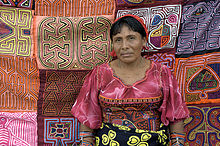
Back Mola (art) Catalan Mola (Nähkunstwerk) German Mola (arte) Spanish Mola (textile) French מולה (אמנות) HE Mola (arte) Italian モラ Japanese Mola (textiel) Dutch Mola (tkanina) Polish Mola (arte têxtil) Portuguese
This article needs additional citations for verification. (November 2023) |

The Mola or Molas is a hand-made textile that forms part of the traditional women's clothing of the indigenous Guna people from Panamá. Their clothing includes a patterned wrapped skirt (saburet), a red and yellow headscarf (musue), arm and leg beads (wini), a gold nose ring (olasu) and earrings in addition to the mola blouse (dulemor).[1] Two groups, Choco and Cuna lived side by side without intermarriage and without adopting a similar culture.[2] In Dulegaya, the Guna's native language, "mola" means "shirt" or "clothing". The mola originated with the tradition of Guna women painting their bodies with geometric designs, using available natural colors; at a certain point, after the arrival of the Spanish, these same designs were woven in cotton, and later still, sewn using cloth "acquired by trade from the ships that came to barter for coconuts during the 19th century".[3][4]
- ^ Emma Capponi (16 October 2020). "Textiles of the World: Molas". Sewcialists.
- ^ Hoover, F. Louis (1969). Molas from the San Blas Islands: a loan exhibition from the F. Louis Hoover Collection of Cuna Art, December 19, 1968-January 19, 1969. Center for Inter-American Relations Art Gallery. OCLC 8962.
- ^ Paul B. Goodwin. "The Molas of San Blas Islands: A Historical Perspective". University of Connecticut - The William Benton Museum of Art. Retrieved 15 August 2023.
- ^ Oswaldo DeLeón Kantule. "Molas". Archived from the original on 21 July 2007. Retrieved 15 August 2023.
© MMXXIII Rich X Search. We shall prevail. All rights reserved. Rich X Search